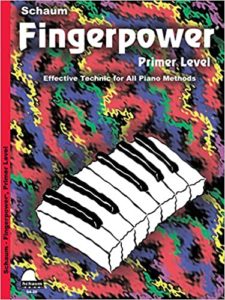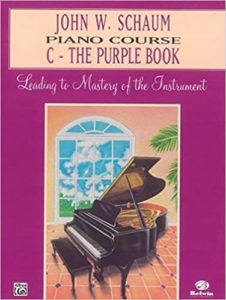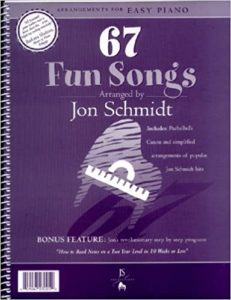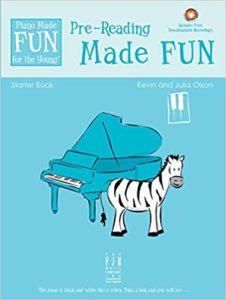Five-Star Books
I’ve taught piano for over 10 years, and I’ve experimented with a lot of method books. Because I wish I could have found a good, solid list of books for various learners when I started teaching, here’s my time-tested recommendations for teachers currently searching.

The Fingerpower series offers solid technique warm-ups that are short, accessible, and not as repetitive as other series like Dozen a Day. I usually start Fingerpower warm-ups after completing a set of primer lesson books. They move quite quickly and there are six levels in the series.

Schaum’s lesson books are very classically based, with 8th notes as well as sharps and flats in the primer level. There is a logical progression into playing in different keys and hand positions, as well as general technique for scales and playing with emotion. There is not much emphasis on creating music, so a supplemental book of popular tunes or chords is necessary, but this is a solid foundation for very motivated students. Book C is around the beginning intermediate level, and H is the final book in the series, which is a perfect jumping-off place for full classical pieces in their original form. I would not recommend this series to a student that does not practice, as it can be overwhelming.
Piano Made Fun is a perfect introduction to music for preschool aged children and very early beginners. If your student is not yet able to track notes across the staff, the picture diagrams of each note of the song are the best way to help them see what it is they are going to do while reading music. The books starts with 2 black keys in the right hand, moves to 2 black keys in the left hand, and then to 3 black keys with each hand, with plenty of songs in each of these positions. The end of the book offers some improv songs with the teacher. The songs are simple and fun, and the themes are appealing to kids.
The Theory Made Fun book that can be bought to accompany this one has well-written Sing-Along songs that cover the concepts your student needs to begin piano and has game suggestions for small groups of children. I love the CD and usually have the students purchase this book to listen to at home, as well as using it myself during the lesson to teach concepts. I often use these two books with Preschoolers and Kindergarteners if they need to visualize concepts. In my opinion, the Counting Made Fun book is best used by the teacher in lessons to teach counting so I don’t recommend having the student purchase it. The Notes Made Fun book has not been super helpful besides the “Cat note C” idea, and I use this one occasionally if the child is super excited about the animals.
NoteReading Made Fun is the second book of the series and starts at C position like most primers but offers plenty of songs to really solidify reading notes. NoteReading Made Fun Book 2 offers many songs in bass C and treble C position to reinforce movement to these new notes, but I often find that students are ready to mix other methods at this point so I have not continued solo with this method past Book 3.

Jon Schmidt’s 67 Fun Songs is a great book for anyone that played the piano as a kid, gave up, and wants to come back years later. It can be done with a teacher, or independently because the book actually includes the 12 weeks of lesson plans for the teacher. I love the approach to just reading notes on the full staff in relation to each other and to the “guide notes” that are on the middle line. It really helps the student visualize steps and skips and move directly to playing lots of notes at the same time. Schmidt recommends the book for ages 8 and up, and I would agree. In fact, I would only do it with older beginners that are ready to try something unconventional that yields results very quickly and that are fully committed to trying it every day for those 12 weeks. I’ve also seen it bring back dormant skills for adults that want to brush up, strengthen left-hand note reading, and be at the hymn-playing level in a few months. And the songs are definitely fun, which stays true to Jon Schmidt and The Piano Guys.
Note Reading Ideas
The best way to learn to read notes is just to read music, all you can and as often as you can. Learn the line and space patterns, or use guide notes, to begin and practice daily. Flashcards are also helpful. I do note flashcards almost every lesson with beginners, and it always pays off by helping them to able to find their own notes, see the relationships between notes, and have confidence in themselves rather than relying on fingering cues or on acronyms to find the notes on the staff. I’ve also accumulated some fun worksheets from around the internet here:
Rhythm Worksheets
My recommendation is to clap and count rhythms separate from songs until you are comfortable with basic note values. Then count songs evenly, and out loud, as you play them. This is sometimes a difficult step to master with children, but it pays off in creating versatile accompanists. Do not count every song; pick one per week. This allows you to both hear and understand rhythm.
I have only found beginning rhythm cards, which I use for clapping and counting rhythms out loud at the lessons, in music stores. But I have made my own 8th-note clap cards, which has helped students overcome this rhythmic stumbling block much faster than other methods. They are able to visualize and vocalize what a half beat sounds like rather than guessing at the rhythm as they play. Cards for different time signatures, dotted quarter notes, and 16ths have also been helpful for students. Occasionally, I have used the following worksheets to reinforce concepts at home:
Chord Playing
1. Start with “ear songs,” or training your ears to find melodies on the piano that are very familiar to you. As you learn five-finger scales, you can look up the key a song is written in online and find the melody from the notes that the author has most likely used.
2. Learn basic chords in root position so you can play along with a lead sheet or online chord sheets of your favorite songs. This is the fun stage where you can sing along with your song in the same way you would sing along with a guitar.
3. Experiment with rhythmic variety in chording, and learn chord inversions to streamline your playing and make use of both hands. At this point, you could play the melody with your right hand and chords in a rhythmic pattern in your left hand. Technically, you’re making a cover for one of your favorite songs!
4. When you are able to imitate popular songs and add variety that you want to add, you could write your own complete songs as well, include friends and other instruments, and form a band or performing group.
Though I encourage students to write music at all phases of their learning and skills, popular music can sometimes be overwhelming when it seems so different than your lesson books. Take the time to understand the theory behind the music and move a step at a time. Here are some handouts that I have found, or made, that have been helpful for students:
